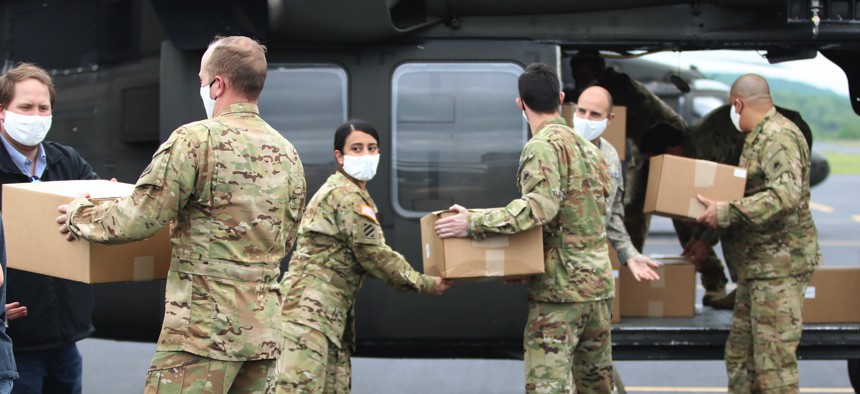
D.C. National Guard soldiers pass boxes of medical face masks to be loaded on a UH-60 Black Hawk helicopter during an aeromedical support mission in Asheboro, N.C., April 25, 2020. Army Staff Sgt. Andrew Enriquez
Lawmakers Ask Trump to Extend National Guard Missions for One Crucial Day
Many pandemic-response missions are slated to end just before Guard troops become eligible for federal benefits.
Lawmakers are calling on President Trump to not end National Guard deployments by June 24 because that could prevent many from becoming eligible for federal benefits.
Politico reported on Tuesday that the Trump administration is ordering a “hard stop” on the deployments of over 40,000 National Guard members who are helping states with their coronavirus responses. For those who were first deployed in March—when the president declared a national emergency for the pandemic—they would be short one day needed to qualify for federal retirement and education benefits. The news outlet said Thursday the administration is now considering extending the deployments until July, but no decision has been made yet.
Over 70 House members called on Defense Secretary Mark Esper on Wednesday to extend the deployments. “This deadline would leave many guardsmen just shy of the 90 days of service required to qualify for certain benefits, like the Post-9/11 GI Bill,” they wrote. “While we hope this is a coincidence, not policy, we request an explanation of the choice of expiration date. To battle this unprecedented crisis, we asked our neighbors in uniform to serve our nation in its time of need.”
The lawmakers added that the administration cutting off support from the National Guard would hinder the national response to the pandemic and shift the burden to states that are already struggling with resources and finances. House Democrats took the lead on the letter, but it has bipartisan support, with Rep. Brian Fitzpatrick, R-Pa., as one of the signatories.
Sen. Gary Peters, D-Mich., sent a similar letter to President Trump on Wednesday. “States remain dependent on the support of National Guard personnel and there are no indications these needs will disappear by June 24th,” he wrote. Also, “purposefully withholding benefits they have earned would be an insult and harm morale, recruiting and retention within the National Guard.” Peters is a member of the Senate Armed Services Committee and a former lieutenant commander in the U.S. Navy Reserve.
In addition to the letters, Sen. Tammy Duckworth, D-Ill., introduced the “National Guard COVID-19 Response Stability Act” on Wednesday, which would ensure all National Guard troops activated during the coronavirus response receive their full benefits. Specifically, it would amend the law to allow governors to order National Guard members on duty for the pandemic to active duty status, so they are guaranteed full federal benefits. This authority would be in place until 30 days after the administration declares the end of the public health emergency for the pandemic. Seventeen Democrats and one independent co-sponsored the bill.
Also, Rep. Jimmy Panetta, D-Calif., plans to introduce legislation on Friday that would affirm guards members can receive benefits by requiring the Defense and Veterans Affairs departments to give Guard members credit for at least 90 days of service, regardless of when their service is supposed to end, according to Politico.
When asked for comment on the report about the “hard stop” for deployments, a Federal Emergency Management Agency spokesperson gave the following statement:
To date, the president has approved 50 National Guard requests for federal support for the use of National Guard personnel in a Title 32 duty status. Through this order, the federal government will fund 100% of the cost for T-32 National Guard orders through June 24. As of May 21, 39,983 National Guard troops have activated in T-32 status and 896 troops have activated in State Active Duty status to help with testing and other response efforts.
A National Guard Bureau spokesman told Government Executive the agency is working with the Defense Department and FEMA “to determine the best ways to care for our guard men and women in this unprecedented response” and they will help for as long as they are needed.
“As in all national-level emergencies, FEMA makes the final decisions regarding the length of time National Guard members are activated under federal orders, while the soldiers and airmen remain under the operational control of the governors,” said the spokesman.
Last Friday, at the White House’s launch of “Operation Warp Speed” to hasten the development, manufacturing and distribution of a coronavirus vaccine, Esper commended the work to help with the pandemic that more than 60,000 service members have done since January.
“Whether it’s doctors and nurses in hospitals, whether it’s National Guard on the streets of America, or the Corps of Engineers continuing to build out capacity in America’s hospitals, we are there and we will be there,” he said. “And we look forward to this next greatest phase of this fight against the coronavirus.”
